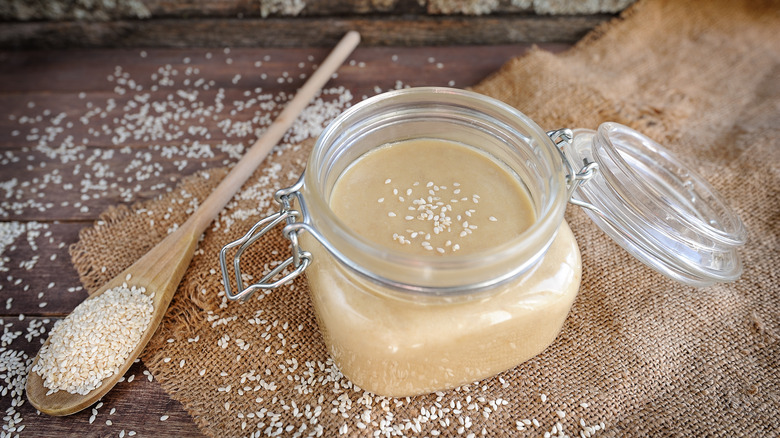Here's How Long Your Tahini Will Stay Good Once You Open It
Tahini is a staple of Middle Eastern cuisine that packs a flavorful punch. You can serve it as a garnish or sauce, mix it into a cake batter, or use it as a condiment in pasta dishes, hot pots, or soups. Its versatility is hard to match, and you might end up buying a bunch of jars when you find a good deal. Luckily, tahini has a long shelf-life and can last unopened for one to two years in the pantry. This gives you plenty of time to use it up and try out different recipes.
Once opened, tahini can be refrigerated to maintain its freshness. Expect it to last from three weeks to one year, depending on its composition and storage conditions. You can also keep it in the pantry after opening the jar, but it may spoil more quickly. Refrigeration will also prevent it from going rancid, though it may result in a thicker consistency.
Tahini's shelf-life may vary from brand to brand
Just like peanut butter, tahini can last a long time due to its high fat content. This creamy condiment is made from ground sesame seeds, which are naturally rich in oils. Just a tablespoon of sesame butter, or tahini, boasts over 8 grams of fat. These oils act as preservatives, helping increase food shelf-life. The downside is that they can also oxidize and turn rancid over time.
Tahini's shelf-life also depends on storage conditions. For instance, excess moisture can lead to microbial growth, whereas light and heat may cause spoilage. The ingredients used play a role, too. Some types of tahini contain cocoa, sugar, natural flavors, and other extras that can affect the product's shelf-life. That's why you should be mindful of expiration dates and check your tahini for signs of spoilage before use.
Generally, pure tahini should last for several months after opening. The oil may separate and come to the top, but you can mix it back in with a teaspoon. This flavorful spread can also thicken over time, especially when refrigerated. If that's the case, give it a good stir or thin it with cold water, yogurt, or olive oil to restore its creamy goodness.
How to tell if your tahini has gone bad
Expired tahini may have a sour smell and taste bitter or rancid. You may also notice significant changes in its texture, such as clumps or moldy spots. In some cases, it may smell like paint or gasoline. Give it a sniff, but don't taste it unless it seems safe to eat. Trust your sense of smell and watch out for any signs of mold or spoilage.
If your tahini is close to its expiration date, consider freezing it for later use. Simply pour it into ice cube trays or small jars, then store it in the freezer for a couple of months. Alternatively, use it up before it goes bad. For example, you could make tahini ice cream, hummus, or dips for veggies, chips, or pitta souvlaki.
Leftover tahini can also be a wonderful addition to brownies, cookies, pies, and cinnamon rolls. If you have a sweet tooth, mix tahini with sugar, salt, vanilla extract, and other ingredients to make halva. Or you can try your hand at Cypriot tahinopitta, a type of pie that's perfect for breakfast or as a quick dessert.


